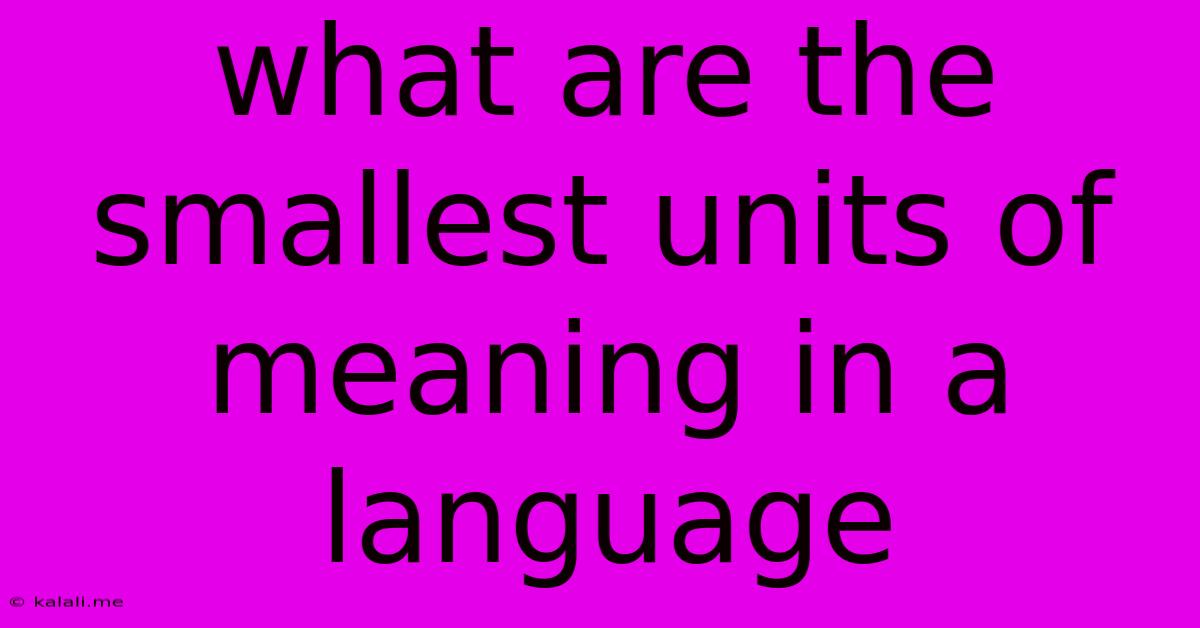What Are The Smallest Units Of Meaning In A Language
Kalali
Jun 12, 2025 · 3 min read

Table of Contents
What Are the Smallest Units of Meaning in a Language? Delving into Morphemes
Understanding how language works is fascinating. We effortlessly string words together to communicate complex ideas, but have you ever considered the fundamental building blocks of meaning within those words? This article explores the smallest units of meaning in a language: morphemes. Understanding morphemes is crucial for anyone interested in linguistics, language acquisition, or even effective writing and communication.
What is a Morpheme?
A morpheme is the smallest unit of meaning in a language that cannot be further divided without losing its meaning. It's the basic component that contributes to the semantic structure of words. Unlike sounds (phonemes), which are units of sound, morphemes carry meaning. Think of them as the fundamental Lego bricks of language, which can be combined to build more complex structures – words and sentences.
Types of Morphemes: Unpacking the Building Blocks
Morphemes fall into two main categories:
-
Free Morphemes: These are morphemes that can stand alone as independent words. They have meaning on their own. Examples include words like "cat," "dog," "run," "happy," and "beautiful." These are the words we typically think of when we talk about language.
-
Bound Morphemes: These morphemes cannot stand alone; they must be attached to other morphemes to have meaning. They are often prefixes or suffixes, but can also be infixes (inserted within a word) although this is less common in English. Examples include:
- Prefixes: un- (unhappy), re- (rewrite), pre- (pregame)
- Suffixes: -ing (running), -ed (walked), -ly (quickly), -s (cats)
- Infixes (less common in English): While less frequent in English, infixes exist in some languages and are inserted within the root word, e.g., (hypothetical example) "sleep" becoming "slee-bloody-p" to add emphasis.
Understanding Morphemes in Action: Examples
Let's break down some words to see morphemes in action:
-
"Unbreakable": This word contains three morphemes: un- (bound morpheme, meaning "not"), break (free morpheme, meaning "to fracture"), and -able (bound morpheme, meaning "capable of").
-
"Cats": This word has two morphemes: cat (free morpheme, meaning a feline animal) and -s (bound morpheme, indicating plurality).
-
"Runners": This contains two morphemes: run (free morpheme, meaning to move swiftly) and -er (bound morpheme, indicating someone who performs the action) and -s (bound morpheme, indicating plurality).
The Importance of Morphemes in Language Learning and Development
Understanding morphemes is crucial for language acquisition, both for children learning their native language and adults learning a new language. Recognizing these fundamental units of meaning helps learners decode new words and understand the nuances of grammar and vocabulary.
Beyond the Basics: Exploring Complexities
While this explanation covers the fundamentals, the study of morphemes delves into more intricate areas. For example, some words contain morphemes that have lost their original meaning over time (e.g., the "-ly" in "lovely" doesn't necessarily adhere strictly to the definition of "like"). The field of morphology explores these intricacies in great detail.
In conclusion, morphemes, the smallest units of meaning in a language, are the foundation upon which words and sentences are built. Understanding them provides a deeper appreciation for the structure and complexity of human language. By recognizing free and bound morphemes, we can better comprehend how words are formed and meaning is conveyed.
Latest Posts
Latest Posts
-
How Is Culture Different From Society
Jun 13, 2025
-
The Place Where An Organism Lives
Jun 13, 2025
-
1 2 6 24 120
Jun 13, 2025
-
Which Of The Following Is Not A Personal Computer
Jun 13, 2025
-
Webcam Is Input Or Output Device
Jun 13, 2025
Related Post
Thank you for visiting our website which covers about What Are The Smallest Units Of Meaning In A Language . We hope the information provided has been useful to you. Feel free to contact us if you have any questions or need further assistance. See you next time and don't miss to bookmark.